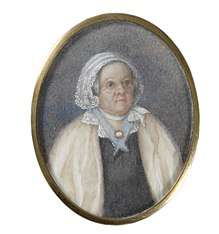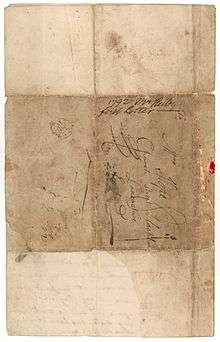Mary Reibey
Mary Reibey née Haydock (12 May 1777 – 30 May 1855) was an English-born merchant, shipowner and trader who was transported to Australia as convict. After gaining her freedom, she was viewed by her contemporaries as a community role model and became legendary as a successful businesswoman in the colony.
Mary Reibey | |
|---|---|
 Portrait of Reibey, miniature watercolour on ivory, dated around 1835 | |
| Born | Molly Haydock 12 May 1777 Bury, Lancashire, England |
| Died | 30 May 1855 (aged 78) Newtown, New South Wales, Australia |
| Resting place | Balmain Cemetery |
| Occupation | Businesswoman |
| Spouse(s) | Thomas Reibey
( m. 1794; died 1811) |
Early life
Reibey baptised Molly Haydock, was born on 12 May 1777 in Bury, Lancashire, England. She was a businesswoman and trader. Following the death of her parents, she was reared by a grandmother and sent into service. She ran away, and was arrested for stealing a horse in August 1791.[1] At the time, she was disguised as a boy and was going under the name of James Burrow.[2] Sentenced to seven years' transportation, she arrived in Sydney, Australia, on the Royal Admiral in October 1792.

Life and career in Australia
On 7 September 1794, 17-year-old Mary married Thomas Reibey, after he had proposed to her several times; she finally agreed to marry the junior officer on the store ship Britannia. Reibey also used the surnames Raiby, Reiby and Reibey interchangeably, but the family adopted the spelling Reibey in later years. Thomas Reibey was granted land on the Hawkesbury River, where he and Mary lived and farmed following their marriage. They built a farmhouse called Reibycroft, which is now listed on the Register of the National Estate.[4]
Thomas Reibey commenced a cargo business along the Hawkesbury River to Sydney and later moved to Sydney. Thomas Reibey's business undertakings prospered, enabling him in 1804 to build a substantial stone residence on a further grant of land near Macquarie Place. He acquired several farms on the Hawkesbury River and traded in coal, cedar, furs and skins. He entered into a partnership with Edward Wills, and trading activities were extended to the Bass Strait, the Pacific Islands and, from 1809 to China and India.[2]
When Thomas Reibey died on 5 April 1811, Mary assumed sole responsibility for the care of seven children and the control of numerous business enterprises. She was no stranger to this task, having managed her husband's affairs during his frequent absences from Sydney. Now a woman of considerable wealth by her husband's businesses, Reibey continued to expand her business interests. In 1812 she opened a new warehouse in George Street and in 1817 extended her shipping operations with the purchase of further vessels. In the same year, the Bank of New South Wales was founded in her house in Macquarie Place.[5][6]
By 1828, when she gradually retired from active involvement in commerce, she had acquired extensive property holdings in the city. Like many others, however, she was on occasions somewhat economical with the truth. In March 1820 she had returned to England with her daughters to visit her native village, and came back to Sydney the next year.[2] So in the 1828 census, when asked to describe her condition, she declared that she "came free in 1821".
In the emancipist Society of New South Wales, she gained respect for her charitable works and her interest in the church and education. She was appointed one of the Governors of the Free Grammar School in 1825.
Reibey built a cottage in the suburb of Hunters Hill, New South Wales circa 1836, where she lived for some time. The cottage, situated on the shores of the Lane Cove River, was later acquired by the Joubert brothers, who enlarged it. It is now known as Fig Tree House and is listed on the (now defunct) Register of the National Estate.[4]
On her retirement, she built a house at Newtown, Sydney, where she lived until her death on 30 May 1855 from pneumonia. She was 78 years old.[7]
An enterprising and determined person of strong personality, during her lifetime Reibey earned a reputation as an astute and successful business woman in the colony of New South Wales. She is featured on the obverse of Australian twenty-dollar notes printed since 1994.[8]
The oldest son of Mary and Thomas Reibey, Thomas Haydock Reibey II (1821-1912: clergyman, farmer and politician), later became the Premier of Tasmania from 1876 to 1877. The Entally Estate was established in 1819 by Thomas Haydock Reibey II in Hadspen, Tasmania. The original house and some outbuildings are now a historic house on the outskirts of Launceston, in northern Tasmania. Mary, the matriarch of the family, had been transported to Australia in 1790 for the crime of horse stealing, then aged 14. She would later marry a junior officer of the East India Company, Thomas Reibey (senior), who established the Entally name as a successful trading company that owned a number of vessels running coal up the Hawkesbury River in New South Wales. Following her husband’s death in 1811, Mary became one of the richest and most successful businesswomen in Australia. She then obtained the grant of 300 acres of land upon which Thomas II was to settle and build the homestead and outbuildings.
Novels
At least three novels have been written based on her life. The novel Sara Dane by Catherine Gaskin, which has sold over 2 million copies, is only loosely factually accurate. It was made into a television mini-series in 1982, which added romantic entanglements and a second-marriage for the character, Sarah Dane, which did not occur for Mary Reibey .[9] More accurate is the novel Mary Reibey by Kathleen Pullen.[10] A neglected but interesting Australian children's author, Nance Donkin's historical children's novel House By the Water (Angus and Robertson; Sydney, 1970: Penguin; Ringwood, 1973) tells part of Mary Reibey's story, but is no longer in print. Donkin also wrote An Emancipist, illustrated by Jane Robinson (Melbourne: Oxford University Press, 1968), a biography of Mary Reibey, written for children.
References
- Daily Telegraph, 12 May 2009, p.37
- Walsh, G. P. "Reibey, Mary (1777-1855)". Australian Dictionary of Biography. National Centre of Biography, Australian National University.
- "Penelope Hope - letter received from her niece Molly Haydock (Mary Reibey), Sydney, 8 October 1792". State Library NSW. Retrieved 15 March 2013.
- The Heritage of Australia, Macmillan Company, 1981, p.2/22
- "Bank of New South Wales". Dictionary of Sydney. 2008. Retrieved 25 November 2018.
- Bank of New South Wales (1974). Australia's first bank : a brief history (2nd ed.). Bank of New South Wales. ISBN 978-0-909719-14-2.
- "Family Notices". The Sydney Morning Herald. XXXVI (5601). 31 May 1855. p. 8 – via National Library of Australia.
- "The Australian $20 Banknote". Reserve Bank of Australia. Archived from the original on 31 August 2012. Retrieved 4 February 2012.
- Gaskin, Catherine (1954). Sara Dane. London & Sydney: Collins.
- Pullen, Kathleen J. (2011). Mary Reibey: The Women on the $20 Note. Sydney: New Holland. originally published by Ure Smith in 1975.
Bibliography
- Cole, Diana Marlay (2016). Mary Reibey ([Corrected edition] ed.). Haymarket, NSW Little Red Apple Publishing. ISBN 978-0-9944361-8-4.CS1 maint: ref=harv (link)
- Drummond, Allan; Lumsden, Glenn, 1964- (2011). Mary Reibey. [Mordialloc, Vic.] [Green Barrow Publishing]. ISBN 978-1-876460-15-0.CS1 maint: multiple names: authors list (link) CS1 maint: ref=harv (link)
- Irvine, Nance (1995). Dear cousin : the Reibey letters. Hale & Iremonger. Retrieved 2 October 2017.CS1 maint: ref=harv (link)
- Irvine, Nance (2001). Mary Reibey - Molly Incognita : a biography of Mary Reibey (1777-1855) and her world. Library of Australian History. ISBN 978-0-9579524-2-3.CS1 maint: ref=harv (link)
- Pike, D (ed), Australian Dictionary of Biography, Vol. 2, Melbourne University Press, 1968.
- Pullen, Kathleen J (2011). Mary Reibey : the woman on the $20 note (2nd ed.). New Holland Publishers. ISBN 978-1-74257-109-6.CS1 maint: ref=harv (link)
- Radi, Heather; Women's Redress Press (1988). 200 Australian women : a Redress anthology. Women's Redress Press. ISBN 978-0-9589603-7-3.CS1 maint: ref=harv (link)
External links
| Wikimedia Commons has media related to Mary Reibey. |